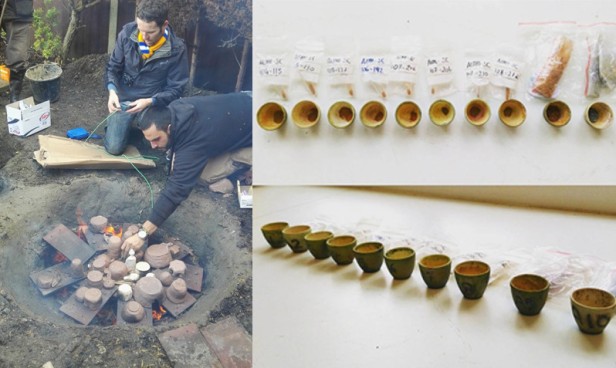Original post on the TwoRains Blog.
Hi again – it is Alessandro, your friendly neighbourhood ceramic specialist.
In the last few weeks, I have been busy re-firing some archaeological ceramics in a furnace at the Department of Geography, University of Cambridge. You might ask “Why do you put ancient pottery in an oven?” Although it is a relatively relaxing activity, there are reasons why we undertake the study of ancient pyro-technologies (from Greek πυρ, pyr, fire).
In the process of producing pottery, the firing stage – and in particular temperatures and structures used – give us important insights into technologies and manufacturing techniques. The sequence of actions that transform clay objects into durable ceramics is one of the crucial stages of ceramic production, and it is possibly the most dramatic. There are a number of approaches that can be used to understand ancient pyro-technologies, ranging from experimental archaeology to analytical techniques. In the photos below, you can see my co-supervisor Patrick Quinn and I doing some experimental archaeology to reconstruct the firing process, including digging out clay, making a kiln, and then carrying out a firing.

For this blog post I will answer some frequent questions that friends and colleagues have recently asked me.
“What to do you mean by firing technologies?” Pottery, firing structures and fuel are all equally important elements in the firing stage. Ancient potters possessed the exact knowledge and skills to combine these elements, along with a very specific understanding of the degree of oxygen (or firing atmosphere) and of firing temperatures (or heating rate) necessary to produce the finished product that they wanted. Knowledge of local environments and seasonal climatic variability was also crucial. After the preliminary work of collecting raw materials and then forming clay objects, including vessels, the ceramic production process culminated with the firing stage. Controlling firing temperatures and other aspects of the firing process is not a simple process. Making mistakes in firing could have resulted in disastrous breakage of vessels, and the unsuccessful end of potentially weeks of hard work.
“How do you pinpoint the exact firing temperature?” Clays and minerals in general transform when exposed to different temperatures, and we are able to observe such variations. Fragments or powder samples collected from ancient vessels can be analysed to understand their mineralogical composition and molecular structure (or molecules absorb frequencies and crystal structure) using methods such as FTIR (which stands for Fourier Transform InfraRed spectroscopy), XRD (X-Ray Diffraction) and SEM (Scanning Electron Microscopy). In order to work out how and what temperatures affect the structure of ceramic materials I have fired raw clays and re-fired archaeological samples at different temperatures. FTIR and XRD analysis have then been carried out following the re-firing process.
The images below show an experimental firing of pottery on the left, and on the right you can see the crucibles that we used to re-fire powder samples of ancient ceramics at the Department of Geography, University of Cambridge.

“What do we know about Indus firing technologies?” We know that different types of kilns were in use concurrently at Indus medium and large-scale settlements (e.g. Mehrgarh, Nausharo, Harappa, and Mohenjo-daro), including “open-air” firing places, single-chamber kilns, and double-chamber updraft kilns. However, there is much that we still need to understand about Indus pyro-technologies – particularly fuels and firing temperatures. Dr Carla Lancelotti did her PhD research on Indus fuels here in Cambridge, including analysis of samples from some Land, Water and Settlement project sites. As part of my research, I aim to understand the whole production sequence of Indus vessels, from raw material collections to firing stage and beyond. Analysis of the pottery itself is showing the long-term use of some technologies, and we now hope to work out whether different firing temperatures were used to produce pottery of different shapes, colours, consistencies and function.
“But why is it important?” As mentioned in previous blog posts, our priority is not just to understand how things were done in the past, but to observe social and cultural behaviors. We want to comprehend how ancient communities and craftspeople saw, perceived and engaged the world, and pottery firing is an important component of that. As Olivier Gosselain (1992) has said, “we want to understand the reasons that motivate the artisans into choosing a particular firing technique” – this will also allow us to observe how skills and knowledge transformed and were transmitted over time, and the degree of regional interaction between communities, including possible technological exchanges.
Yours truly,
Alessandro Ceccarelli
